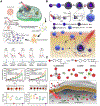Light: A Magical Tool for Controlled Drug Delivery
- PMID: 34483808
- PMCID: PMC8415493
- DOI: 10.1002/adfm.202005029
Light: A Magical Tool for Controlled Drug Delivery
Abstract
Light is a particularly appealing tool for on-demand drug delivery due to its noninvasive nature, ease of application and exquisite temporal and spatial control. Great progress has been achieved in the development of novel light-driven drug delivery strategies with both breadth and depth. Light-controlled drug delivery platforms can be generally categorized into three groups: photochemical, photothermal, and photoisomerization-mediated therapies. Various advanced materials, such as metal nanoparticles, metal sulfides and oxides, metal-organic frameworks, carbon nanomaterials, upconversion nanoparticles, semiconductor nanoparticles, stimuli-responsive micelles, polymer- and liposome-based nanoparticles have been applied for light-stimulated drug delivery. In view of the increasing interest in on-demand targeted drug delivery, we review the development of light-responsive systems with a focus on recent advances, key limitations, and future directions.
Keywords: Light; drug delivery; photochemical; photoisomerization; photothermal.
Figures











References
-
- Paull R, Wolfe J, Hébert P, Sinkula M, Nat. Biotechnol 2003, 21, 1144. - PubMed
-
- Karimi M, Bahrami S, Ravari SB, Zangabad PS, Mirshekari H, Bozorgomid M, Shahreza S, Sori M, Hamblin MR, Expert Opin. Drug Deliv 2016, 13, 1609; - PMC - PubMed
- Wang H, Ke F, Mararenko A, Wei Z, Banerjee P, Zhou S, Nanoscale 2014, 6, 7443; - PubMed
- Robinson JT, Tabakman SM, Liang Y, Wang H, Sanchez Casalongue H, Vinh D, Dai H, J. Am. Chem. Soc 2011, 133, 6825; - PubMed
- Karimi M, Solati N, Amiri M, Mirshekari H, Mohamed E, Taheri M, Hashemkhani M, Saeidi A, Estiar MA, Kiani P, Ghasemi A, Basri SMM, Aref AR, Hamblin MR, Expert Opin. Drug Deliv 2015, 12, 1071; - PMC - PubMed
- Liu JL, Dixit AB, Robertson KL, Qiao E, Black LW, Proc. Natl. Acad. Sci. USA 2014, 111, 13319; - PMC - PubMed
- Hosseinidoust Z, Mostaghaci B, Yasa O, Park B-W, Singh AV, Sitti M, Adv. Drug Delivery Rev 2016, 106, 27; - PubMed
- Karimi M, Eslami M, Sahandi-Zangabad P, Mirab F, Farajisafiloo N, Shafaei Z, Ghosh D, Bozorgomid M, Dashkhaneh F, Hamblin MR, Wiley Interdiscip. Rev.: Nanomed. Nanobiotechnol 2016, 8, 696; - PMC - PubMed
- Karimi M, Sahandi Zangabad P, Ghasemi A, Amiri M, Bahrami M, Malekzad H, Ghahramanzadeh Asl H, Mahdieh Z, Bozorgomid M, Ghasemi A, Rahmani Taji Boyuk MR, Hamblin MR, ACS Appl. Mater. Inter 2016, 8, 21107; - PMC - PubMed
- Wang L, Yuan Y, Lin S, Huang J, Dai J, Jiang Q, Cheng D, Shuai X, Biomaterials 2016, 78, 40; - PubMed
- Huang S, Liu J, He Q, Chen H, Cui J, Xu S, Zhao Y, Chen C, Wang L, Nano Research 2015, 8, 4038.
-
- Heo DN, Ko WK, Moon HJ, Kim HJ, Lee SJ, Lee JB, Bae MS, Yi JK, Hwang YS, Bang JB, Kim EC, Do SH, Kwon IK, ACS Nano 2014, 8, 12049; - PubMed
- Bensellam M, Laybutt DR, Jonas J-C, Mol. Cell. Endocrinol 2012, 364, 1; - PubMed
- Karimi M, Zare H, Bakhshian Nik A, Yazdani N, Hamrang M, Mohamed E, Sahandi Zangabad P, Moosavi Basri SM, Bakhtiari L, Hamblin MR, Nanomedicine 2016, 11, 513; - PMC - PubMed
- Carrasco E, Calvo MI, Blázquez-Castro A, Vecchio D, Zamarrón A, de Almeida IJD, Stockert JC, Hamblin MR, Juarranz Á, Espada J, J. Invest. Dermatol 2015, 135, 2611; - PMC - PubMed
- Abrahamse H, Hamblin MR, Biochem. J 2016, 473, 347; - PMC - PubMed
- Yu C, Avci P, Canteenwala T, Chiang LY, Chen BJ, Hamblin MR, J. Nanosci.Nanotechnol 2016, 16, 171. - PMC - PubMed
-
- Wang Y, Li B, Zhang L, Song H, Zhang L, ACS Appl. Mater. Inter 2012, 5, 11.
Grants and funding
LinkOut - more resources
Full Text Sources
